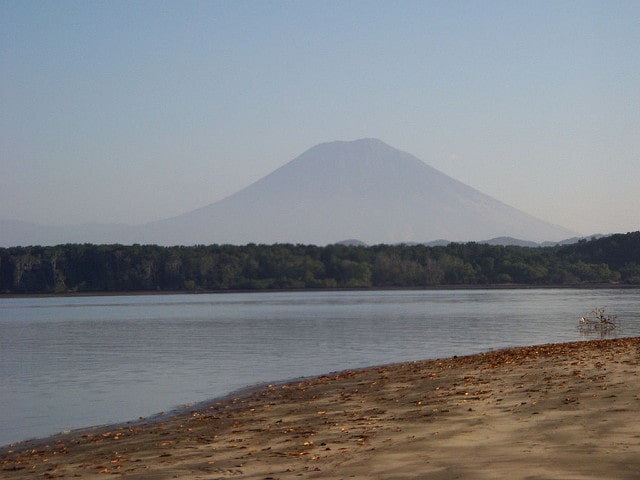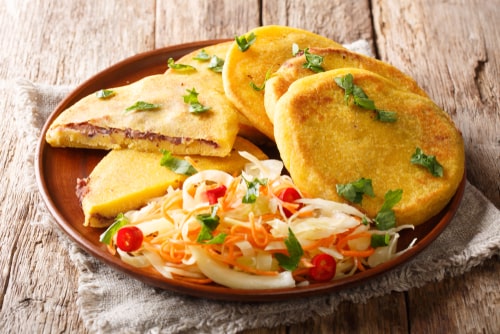Last updated on October 15th, 2022
Economy of El Salvador
37. The country’s minimum wage is US $100-250 a month.
38. The white colored stripes on the country’s flag symbolize peace, and the Blue stripes symbolize unity. The country officially adopted its flag in 1910.
Flag of El Salvador

39. The United States houses approximately three million Salvadorans. These people live in the U.S. for work and send money back home to support their families.
40. Coffee exports accounted for 90% of the country’s earnings by the early 20th century. However, the country has diversified its income sources by establishing a manufacturing sector in its territory, and building trade and financial links with other countries.
Associated People
41. The parents of Tennis Hall of Famer Rosie Casals emigrated from El Salvador to the United States.
42. American supermodel Christy Turlington also has roots in El Salvador.
43. Pope John Paul II also visited the country many a time prior to his illness.
44. The civil war in the country took place from 1980 to 1992. During the period, almost 75,000 lives were lost. Economic inequality was the reason for the war.

Facts that make El Salvador stand out among other Central American countries
45. San Salvador, the capital of El Salvador, has one of the biggest shopping center in all of Central America. It is also famous for its many museums and cultural sites.
46. The country also houses one of the largest airports in all of Central America.
47. Salvadoran countrymen were involved in an infamous “100 Hour War” with neighbouring Honduras in 1969, after a soccer game.
48. It is estimated that Qatar’s 2022 World Cup will take more lives than 9/11 due to horrible working conditions for migrant workers building stadiums and infrastructure.
49. El Salvador is also known as “the land of Volcanoes.” It has more than 20 volcanoes, and the Chaparrastique is considered to be the most active volcano in the region. It has erupted 26 times in the last 500 years.

50. The only UNESCO World Heritage Site in El Salvador is Joya de Cerén. The remains of a prehispanic farming village that was covered by a volcanic eruption in the seventh century AD can be found on the site. It is also called the “Pompeii of the Americas.”
51. The film Salvador was also released on the subject of the 12-year civil war. Interestingly, the movie was also nominated for Oscars.
Interesting facts about El Salvador’s culture
52. The people of El Salvador are friendly, warm and hospitable.
53. It is a tradition in El Salvador for women to often pat each other on the right forearm or shoulder instead of shaking hands.
54. This is how they greet each other depending on the time of the day: “buenos dias”(good morning), “buenas tardes” (good afternoon) or “buenas noches” (good evening).
55. The use of first names is usually reserved for family and friends.
56. The 15th birthday of a young girl is widely celebrated and is an important event in her — and her family’s — life.

57. El Salvador’s most notable dish is the “Pupusa,” a thick handmade corn flour or rice flour tortilla.
58. Tortillas, rice, and beans are the main foods in El Salvador.
59. Salvadorans like to receive perfumes as gifts.
60. Food is always eaten with utensils. Yeah, they use forks for eating fruits, too!
61. Salvadorans have a strong sense of personal pride, honor, and dignity.
Learn more about trade and craft in El Salvador with this link.
About the flag of El Salvador

1. Design and Symbolism
The flag of El Salvador, called Bandera Magna, celebrates the country’s Central American heritage. It has three horizontal bands. The blue edges represent the oceans surrounding Central America and the skies above. Meanwhile, the middle white band signifies peace, harmony, and solidarity with the rest of the world.
The country’s coat of arms appears at the center. It has a golden amber triangle for the three branches of government. Inside are five volcanoes inspired by the peaks of the Cordillera de Apaneca. They represent the five members of the United Provinces of Central America: El Salvador, Costa Rica, Guatemala, Honduras, and Nicaragua.
Above the volcanoes is a red Phrygian cap that symbolizes liberty. Behind it is a white sun with visible rays. These represent God’s presence throughout the land. A rainbow also appears as a biblical symbol of the covenant to preserve life on Earth. The date encircling the sun is their Independence Day: 15 Septiembre de 1821.
At the back are five striped flags of the former Federal Republic of Central America. They hang from war spears that honor native people. Under these is the motto “Dios Union Libertad.” A 14-part laurel wreath sits at the bottom to represent the 14 administrative departments around the country. Lastly, a golden text surrounds the coat of arms: “Republica de El Salvador en la America Central.”
2. Adoption
El Salvador adopted the flag on May 27, 1912, during the presidency of Manuel Enrique Araujo. The doctor and politician was a patron of the arts who supported the construction of the National Theater. He also inaugurated an independence monument and adopted the country’s coat of arms.
3. Technical Details
The flag has an unusual proportion of 189:335, typically simplified into 9:16. The cobalt blue bands fall between HEX 024BFB and 0F45D2 in the RGB color scheme. The texts use two typefaces: Trajan and Boris Black Bloxx.
4. History
In the 16th century, the Spanish Empire colonized Central America and ruled it from Mexico City. However, the distance made management difficult. In 1609, the region became an autonomous administrative unit called the Captaincy General of Guatemala. During this time, various Spanish flags flew over the land. They include the Cross of Burgundy and the red-yellow Spanish flag with a simplified seal.
In the early 1800s, the French and American revolutions inspired the locals to gain independence from Spanish authorities. They achieved it in 1821. The free territories united to form the Federal Republic of Central America. Its flag was a horizontal triband with a triangular coat of arms depicting five volcanoes. The union dissolved in 1841, but there were several attempts to regroup in the decades that followed.
El Salvador had no choice but to forge its path as a sovereign state. Oligarchs from coffee plantations comprised the ruling class until a military takeover in 1898. In 1911, Manuel Enrique Araujo became the first civilian president since the coup d’etat. He encouraged the creation of a new coat of arms and national flag. The chosen design mirrors the old Central American flag.
5. Variant Flags
El Salvador has two variant flags with minor modifications from the Bandera Magna. The civil flag and ensign is a horizontal triband without the coat of arms. Meanwhile, the alternate state flag is a triband with the motto “DIOS UNION LIBERTAD” in golden amber at the center.
El Salvador – country at a glance
| Independence | 15 September 1821 (from Spain) |
|---|---|
| Capital City | San Salvador (13°40′N 89°10′W) |
| Largest City | San Salvador (13°40′N 89°10′W) |
| Total area | total : 21,041 sq km land: 20,721 sq km water: 320 sq km (about the same size as New Jersey) |
| Population | 6,628,702 (2024 est.) |
| Suffrage | 18 years of age; universal |
| Literacy | total population: 89.1% (2019 est.) |
| Life expectancy at birth | 75.9 years (2024 est.) Life expectancy at birth indicates the number of years a newborn infant would live if prevailing patterns of mortality at the time of its birth were to stay the same throughout its life. |
| Official Language | Spanish |
| Government type | presidential republic |
| President | Nayib Bukele |
| National anthem | "Himno Nacional de El Salvador" (National Anthem of El Salvador) |
| National symbol | turquoise-browed motmot (bird) |
| National colors | blue, white |
| Demonym | Salvadoran |
| Borders | Guatemala and Honduras |
| Currency | USD (US Dollar) |
| Religion | Christianity and others |
| Climate | tropical; rainy season (May to October); dry season (November to April); tropical on coast; temperate in uplands |
| Coastline | 307 km |
| Terrain | mostly mountains with narrow coastal belt and central plateau |
| Mean elevation | 442 m |
| Lowest point | Pacific Ocean 0 m |
| Highest point | Cerro El Pital 2,730 m |
| Natural resources | hydropower, geothermal power, petroleum, arable land |
| Agricultural land | 74.7% |
| Birth rate | 17.1 births/1,000 population (2024 est.) |
| Death rate | 5.9 deaths/1,000 population (2024 est.) |
| Sex ratio | 0.92 male(s)/female (2024 est.) |
| Industries | food processing, beverages, petroleum, chemicals, fertilizer, textiles, furniture, light metals |
| Exports | $11.586 billion (2024 est.) garments, plastic products, electrical capacitors, raw sugar, toilet paper (2023) |
| Imports | $18.354 billion (2024 est.) refined petroleum, natural gas, garments, packaged medicine, plastics (2023) |
| GDP - per capita (PPP) | $11,700 (2024 est.) |
| Internet country code | .sv |
| Time Zone | CST (UTC−6) |
| Calling Code | +503 |
| Drives on the | Right |
| Table last updated | October 05, 2025 |
